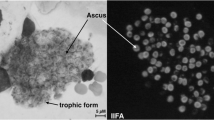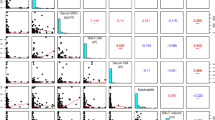Abstract
The incidence of invasive fungal infections (IFI) has increased in recent years, especially among immunocompromised hosts (ICH). In 2003, the Fungitell® assay received FDA clearance for the presumptive diagnosis of IFI using serum and detects (1-3)-β-d-glucan, which is a major cell wall component of certain fungi (e.g., Candida, Aspergillus, and Pneumocystis). The goal of the current study was to assess the performance of the assay on bronchoalveolar lavage (BAL) fluid and serum to identify IFI in ICH. Patients were classified as having proven, probable, possible, or no IFI according to the European Organization for Research and Treatment of Cancer/Mycoses Study Group (EORTC/MSG) guidelines. Among 109 patients for whom the results of Fungitell were compared to the EORTC/MSG criteria, Fungitell showed a low positive predictive value for the identification of IFI from both BAL (20.0 %) and serum (26.7 %). However, the negative predictive value of Fungitell was significantly higher for both sample types (BAL, 83.0 %; serum, 84.8 %). Interestingly, the results of Fungitell were positive in BAL and serum in 7/8 (87.5 %) patients diagnosed with Pneumocystis pneumonia (PcP) by real-time, non-nested PCR. These data indicate that the Fungitell assay has a low positive predictive value for the diagnosis of IFI in ICH, regardless of the specimen type that is tested. However, testing of serum samples by Fungitell may permit a rapid and noninvasive initial screening approach in patients with presumed PcP.

Similar content being viewed by others
References
Cuenca-Estrella M, Bernal-Martinez L, Buitrago MJ, Castelli MV, Gomez-Lopez A, Zaragoza O, et al. Update on the epidemiology and diagnosis of invasive fungal infection. Int J Antimicrob Agents. 2008;32(Suppl 2):S143–7.
Clark TA, Hajjeh RA. Recent trends in the epidemiology of invasive mycoses. Curr Opin Infect Dis. 2002;15(6):569–74.
Odabasi Z, Mattiuzzi G, Estey E, Kantarjian H, Saeki F, Ridge RJ, et al. Beta-d-glucan as a diagnostic adjunct for invasive fungal infections: validation, cutoff development, and performance in patients with acute myelogenous leukemia and myelodysplastic syndrome. Clin Infect Dis. 2004;39(2):199–205.
Erjavec Z, Kluin-Nelemans H, Verweij PE. Trends in invasive fungal infections, with emphasis on invasive aspergillosis. Clin Microbiol Infect. 2009;15(7):625–33.
Pickering JW, Sant HW, Bowles CA, Roberts WL, Woods GL. Evaluation of a (1→3)-β-d-glucan assay for diagnosis of invasive fungal infections. J Clin Microbiol. 2005;43(12):5957–62.
Miceli MH, Lee SA. Emerging moulds: epidemiological trends and antifungal resistance. Mycoses 2011.
Miceli MH, Diaz JA, Lee SA. Emerging opportunistic yeast infections. Lancet Infect Dis. 2011;11(2):142–51.
Mikolajewska A, Schwartz S, Ruhnke M. Antifungal treatment strategies in patients with haematological diseases or cancer: from prophylaxis to empirical, pre-emptive and targeted therapy. Mycoses. 2011.
Jones BL, McLintock LA. Impact of diagnostic markers on early antifungal therapy. Curr Opin Infect Dis. 2003;16(6):521–6.
Morrell M, Fraser VJ, Kollef MH. Delaying the empiric treatment of Candida bloodstream infection until positive blood culture results are obtained: a potential risk factor for hospital mortality. Antimicrob Agents Chemother. 2005;49(9):3640–5.
Limper AH, Knox KS, Sarosi GA, Ampel NM, Bennett JE, Catanzaro A, et al. An official american thoracic society statement: treatment of fungal infections in adult pulmonary and critical care patients. Am J Respir Crit Care Med. 2011;183(1):96–128.
Paterson DL, Singh N. Invasive Aspergillosis in transplant recipients. Medicine (Baltimore). 1999;78(2):123–38.
Singh N, Paterson DL. Aspergillus infections in transplant recipients. Clin Microbiol Rev. 2005;18(1):44–69.
Ahmad S, Khan ZU, Theyyathel AM. Diagnostic value of DNA, (1-3)-β-d-glucan, and galactomannan detection in serum and bronchoalveolar lavage of mice experimentally infected with Aspergillus terreus. Diagn Microbiol Infect Dis. 2007;59(2):165–71.
Held J, Koch MS, Reischl U, Danner T, Serr A. Serum (1→3)-beta-d-glucan measurement as an early indicator of Pneumocystis jirovecii pneumonia and evaluation of its prognostic value. Clin Microbiol Infect. 2011;17(4):595–602.
Posteraro B, Torelli R, De Carolis E, Posteraro P, Sanguinetti M. Update on the laboratory diagnosis of invasive fungal infections. Mediterr J Hematol Infect Dis 2011;3.
Pazos C, Ponton J, Del Palacio A. Contribution of (1→3)-β-d-glucan chromogenic assay to diagnosis and therapeutic monitoring of invasive aspergillosis in neutropenic adult patients: a comparison with serial screening for circulating galactomannan. J Clin Microbiol. 2005;43(1):299–305.
Karageorgopoulos DE, Vouloumanou EK, Ntziora F, Michalopoulos A, Rafailidis PI, Falagas ME. Beta-d-glucan assay for the diagnosis of invasive fungal infections: a meta-analysis. Clin Infect Dis. 2011;52(6):750–70.
Ostrosky-Zeichner L, Alexander BD, Kett DH, Vazquez J, Pappas PG, Saeki F, et al. Multicenter clinical evaluation of the (1→3) beta-d-glucan assay as an aid to diagnosis of fungal infections in humans. Clin Infect Dis. 2005;41(5):654–9.
Khan ZU, Ahmad S, Theyyathel AM. Diagnostic value of DNA and (1→3)-β-d-glucan detection in serum and bronchoalveolar lavage of mice experimentally infected with Fusarium oxysporum. J Med Microbiol. 2008;57:36–42.
Arcenas RC, Uhl JR, Buckwalter SP, Limper AH, Crino D, Roberts GD, et al. A real-time polymerase chain reaction assay for detection of Pneumocystis from bronchoalveolar lavage fluid. Diagn Microbiol Infect Dis. 2006;54(3):169–75.
Wilson JW, Limper AH, Grys TE, Karre T, Wengenack NL, Binnicker MJ. Pneumocystis jirovecii testing by real-time polymerase chain reaction and direct examination among immunocompetent and immunosuppressed patient groups and correlation to disease specificity. Diagn Microbiol Infect Dis. 2011;69(2):145–52.
De Pauw B, Walsh TJ, Donnelly JP, Stevens DA, Edwards JE, Calandra T, et al. Revised definitions of invasive fungal disease from the European Organization for Research and Treatment of Cancer/Invasive Fungal Infections Cooperative Group and the National Institute of Allergy and Infectious Diseases Mycoses Study Group (EORTC/MSG) Consensus Group. Clin Infect Dis. 2008;46(12):1813–21.
Mennink-Kersten MA, Ruegebrink D, Verweij PE. Pseudomonas aeruginosa as a cause of 1,3-beta-d-glucan assay reactivity. Clin Infect Dis. 2008;46(12):1930–1.
Heyland D, Jiang X, Day AG, Laverdiere M. Serum beta-d-glucan of critically ill patients with suspected ventilator-associated pneumonia: preliminary observations. J Crit Care 2011.
Shahid Z, Kumar NS, Restrepo A, Haider S, Muzaffar J, Grazziutii M et al. Elevated serum β-d-glucan (BDG) as a marker for chemotherapy-induced mucosal barrier injury (MBI) in adults with hematologic malignancies: a retrospective analysis. 2011.
Ishizuka Y, Tsukada H, Gejyo F. Interference of (1→3)-β-d-glucan administration in the measurement of plasma (1→3)-β-d-glucan. Intern Med. 2004;43(2):97–101.
Viscoli C, Machetti M, Cappellano P, Bucci B, Bruzzi P, Van Lint MT, et al. False-positive galactomannan platelia Aspergillus test results for patients receiving piperacillin-tazobactam. Clin Infect Dis. 2004;38(6):913–6.
Damiani C, Le Gal S, Lejeune D, Brahimi N, Virmaux M, Nevez G, et al. Serum (1→3)-β-d-glucan levels in primary infection and pulmonary colonization with Pneumocystis jirovecii. J Clin Microbiol. 2011;49(5):2000–2.
Desmet S, Van Wijngaerden E, Maertens J, Verhaegen J, Verbeken E, De Munter P, et al. Serum (1-3)-β-d-glucan as a tool for diagnosis of Pneumocystis jirovecii pneumonia in patients with human immunodeficiency virus infection or hematological malignancy. J Clin Microbiol. 2009;47(12):3871–4.
Sax PE, Komarow L, Finkelman MA, Grant PM, Andersen J, Scully E, et al. Blood (1→3)-β-d-glucan as a diagnostic test for HIV-related Pneumocystis jirovecii pneumonia. Clin Infect Dis. 2011;53(2):197–202.
Marty FM, Koo S, Bryar J, Baden LR. (1→3) β-d-glucan assay positivity in patients with Pneumocystis (carinii) jirovecii pneumonia. Ann Intern Med 2007;147(1).
Akamatsu N, Sugawara Y, Kaneko J, Tamura S, Makuuchi M. Preemptive treatment of fungal infection based on plasma (1→3) β-d-glucan levels after liver transplantation. Infection. 2007;35(5):346–51.
Presterl E, Parschalk B, Bauer E, Lassnigg A, Hajdu S, Graninger W. Invasive fungal infections and (1,3)-β-d-glucan serum concentrations in long-term intensive care patients. Int J Infect Dis. 2009;13(6):707–12.
Lamoth F, Cruciani M, Mengoli C, Castagnola E, Lortholary O, Richardson M, et al. beta-glucan antigenemia assay for the diagnosis of invasive fungal infections in patients with hematological malignancies: a systematic review and meta-analysis of cohort studies from the third European Conference on Infections in Leukemia (ECIL-3). Clin Infect Dis. 2012;54(5):633–43.
Conflict of interest
BJM is an employee at Associates of Cape Cod. Beacon Diagnostics supported this study by performing the Fungitell testing on serum and BAL samples.
Author information
Authors and Affiliations
Corresponding author
Rights and permissions
About this article
Cite this article
Theel, E.S., Jespersen, D.J., Iqbal, S. et al. Detection of (1, 3)-β-d-glucan in bronchoalveolar lavage and serum samples collected from immunocompromised hosts. Mycopathologia 175, 33–41 (2013). https://doi.org/10.1007/s11046-012-9579-y
Received:
Accepted:
Published:
Issue Date:
DOI: https://doi.org/10.1007/s11046-012-9579-y




